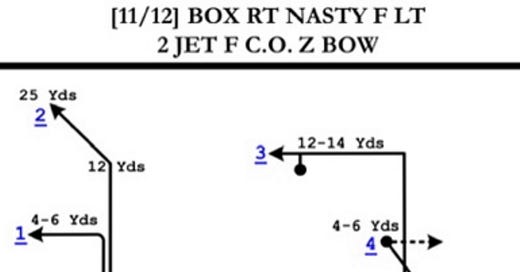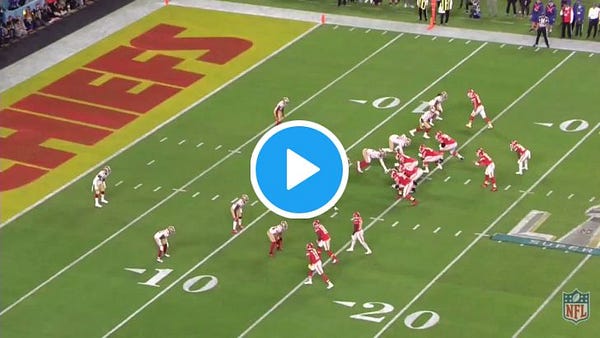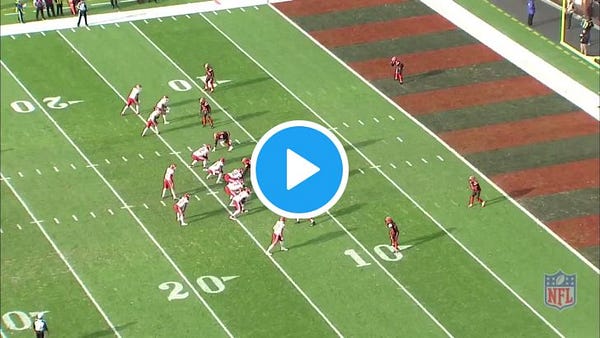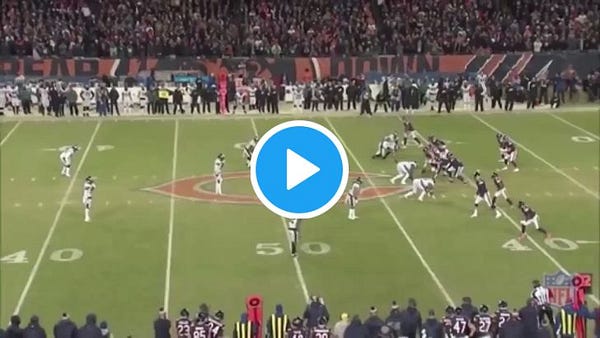The Chiefs’ Tampa HB choice concept
The bow concept is a common play in the west coast offense. It’s called bow as it’s the same as the west coast play arrow (snag or Y-corner in air raid terminology) but with a dig instead of a corner. The other two routes that form bow are a spot route and a flat route.


Most of the time play resembles the bow concept mentioned above, but as the receiver has the option to run a corner, it can also resemble an arrow/spot (snag or Y-corner) concept. The Chiefs mostly likely call this combination between arrow and bow, Tampa, as this is what Doug Pederson and the Eagles call it.

The receiver usually runs a dig, not a corner
The play is usually ran from a bunch, which is always to the field.
Either arrow or bow from a bunch works well against a box coverage (which is probably the most common check against bunches) as it will place the spot route receiver one-on-one with the cornerback, who will have high and outside leverage. Nick Saban came up with what he calls ‘bingo’ in order to defend against concepts like this or ones like spacing from bunches, as in bingo the cornerback will play the spot route much more aggressively.
On the backside of the play they run HB choice/read. HB choice simply consists of a corner route from the single receiver and an option route from the back. This is a commonly used concept on the backside of trips formations. As shown in the diagram above, the tight end has the ability to run a corner post (copper)
Even though it’s not a mirrored concept, it’s still a choose a side concept for the quarterback. If he chooses the HB choice side, he reads from high-to-low. If he turns down both options his third read is the dig. If he chooses the Tampa (bow/arrow) side, he reads from out to in (flat or bubble, spot, dig).
It’s essentially a man-zone read but sometimes the quarterback reads the Tampa side when it’s man and vice versa. It’s not the best play against man as the single receiver will have bad leverage due to his tight split, leaving the option as the only good man beating route. Defenses frequently ‘flood’ the trips side and leave the single receiver and back one-on-one when playing zone. Again, this leaves the back as the only good option, but HB option routes against LB’s with lots of space to work with are probably the most efficient routes to throw, especially when to the boundary.
I’ve seen the quarterback throw hot to both the flat and the option when hot so it must be based on which side he had decided upon pre-snap.
Defenses quite often cloud the corner (stay in flat) when facing nub formations (TE as the single receiver). As HB choice will usually turn into smash against zone, it should do a good job of defeating a cloud corner.
The Chiefs had ways to adjust the formation, usually to a 2X2 with the back to the boundary. They run the same bow concept to the boundary, while to the field they run a fade from the #1 and a slot option from the #2. The concept, protection, and read stay the same.
The Eagles also pair Tampa with other concepts.




An interesting point to note is that when running “Tampa HB choice”, it’s always ran from a bunch, while all of the other variations of Tampa are from 2X2. The only plausible explanation for this is that when running Tampa it’s usually the primary concept, but when running it with HB choice, it’s usually secondary. So, when ran from a bunch it will attract more defenders away from the HB choice side than if it was 2X2.
This is a common theme I’ve noticed from Reid and Pederson: bunches are mostly decoys.
Another coach in the Andy Reid tree is Bears’ coach, Matt Nagy. Unsurprisingly, the Bears run Tampa HB choice frequently.
Likely the main reason they run it more often than the Chiefs is that Nagy likes to use Tarik Cohen as a receiving threat, while Reid doesn’t use his backs much as receiving threats. That will likely change with the addition of Clyde Edwards-Helaire as he is lethal on option routes.
One adjustment that I personally like is to have the single receiver (usually a TE) inside release and pretend to pick/rub the apex defender (or whoever is responsible for the back). As defenses will usually expect some type of rub when the single receiver has a tight split, the defender responsible for the back will usually look to beat the back to the outside as he will usually be running some type of rail route. With the defender flowing fast to the outside, the back should win easily on his option route.
This is a great change up if you run mesh rail, like the Chiefs do occasionally.
https://alexbyrne.substack.com/p/chiefs-mesh-concept
A lot of teams run arrow/snag, so that side of the concept is nothing new, but pairing HB choice with snag is something I hadn’t seen before, and is my favorite way of snag as there will usually be lots of space to work with for your back as the defense will usually flood the coverage to the bunch.








